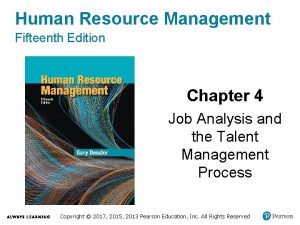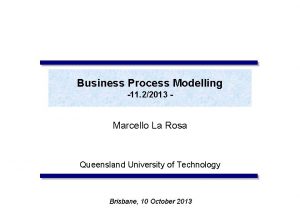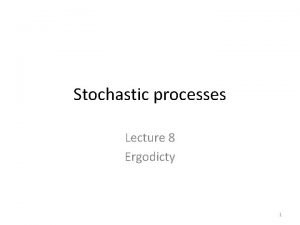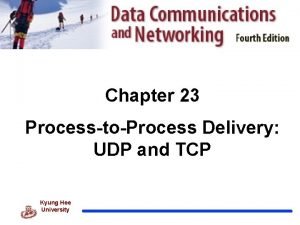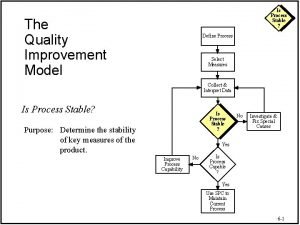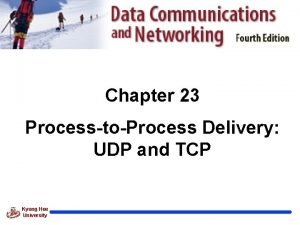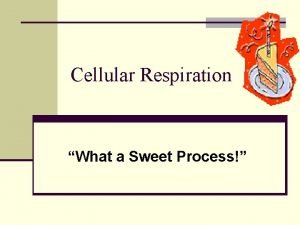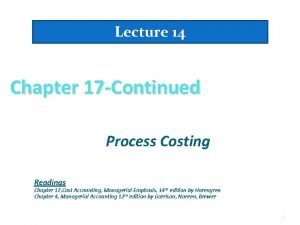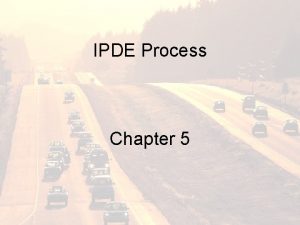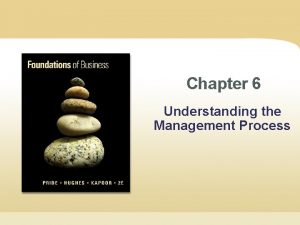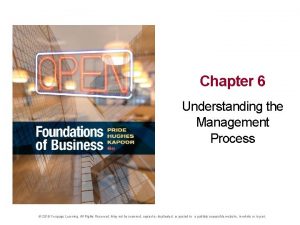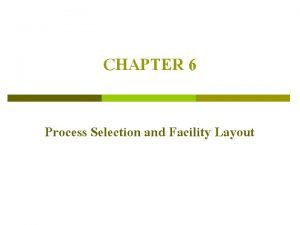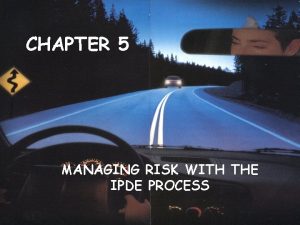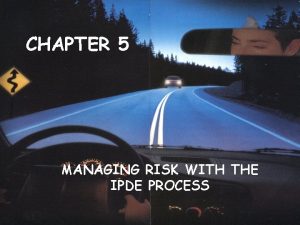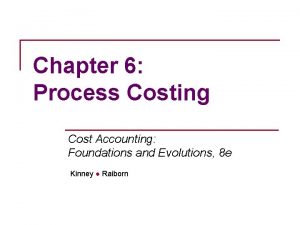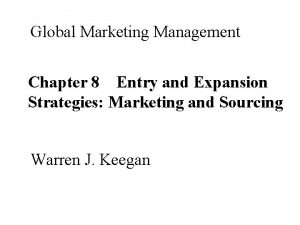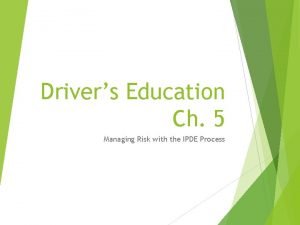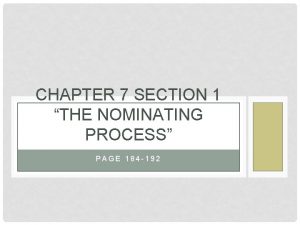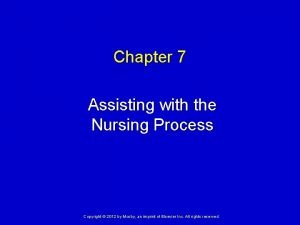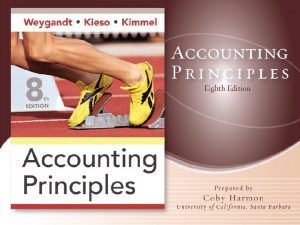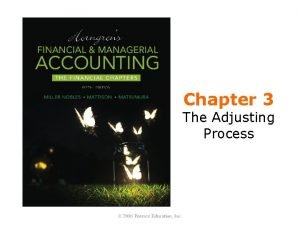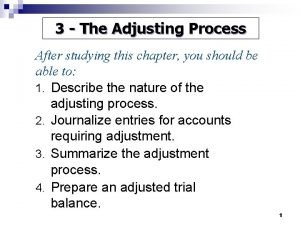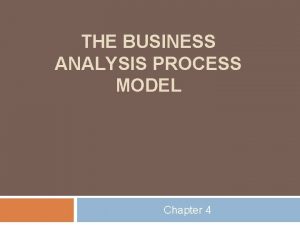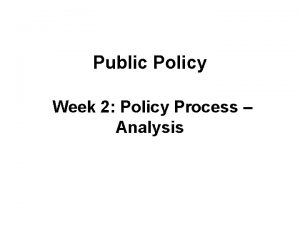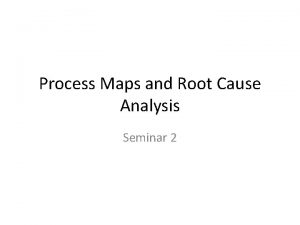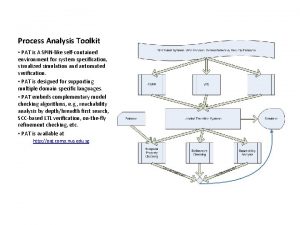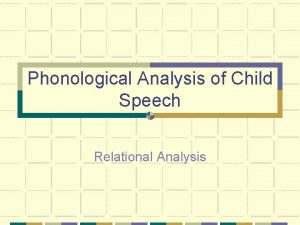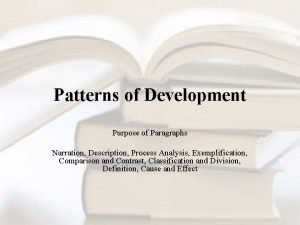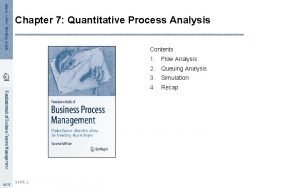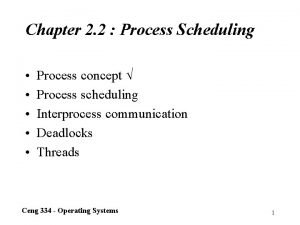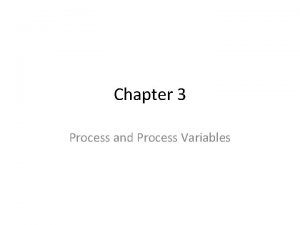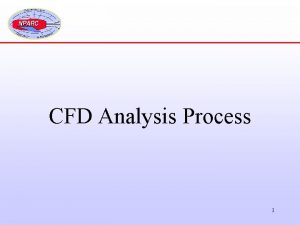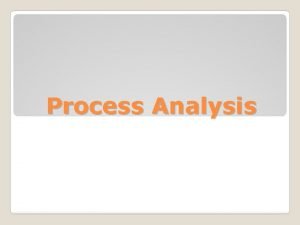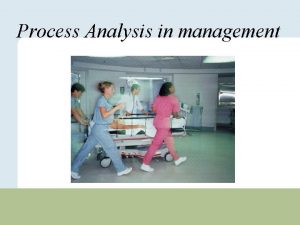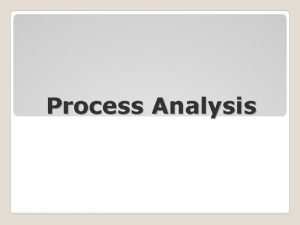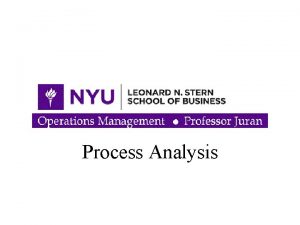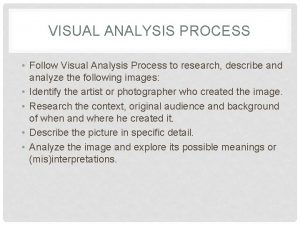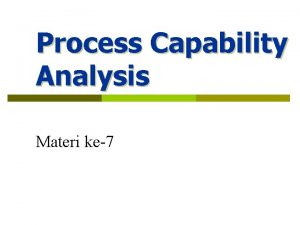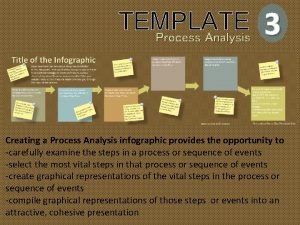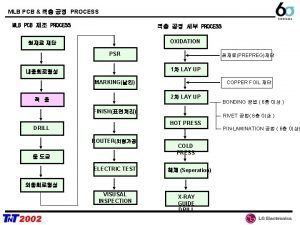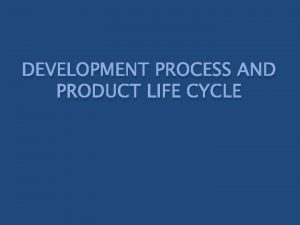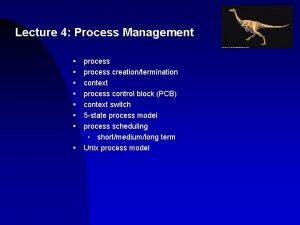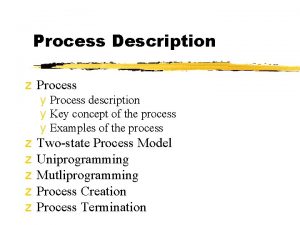Chapter 5 Process Analysis 1 Analysis n Analysis






















































- Slides: 54

Chapter 5 Process Analysis 1

Analysis n Analysis is the examination of processes, facts, and data to gain an understanding of why problems occur and where opportunities for improvement exist. – Statistical inference is the process of drawing conclusions about unknown characteristics of a population from which data were taken. – Predictive statistics focus on cause-and-effect relationships and predictions of future performance from historical data. 2

Basic Probability Concepts n n An experiment is a process that results in some outcome. The outcome of an experiment is a result that we observe The collection of all possible outcomes of an experiment is called the sample space. Probability is the likelihood that an outcome occurs. 3

Probability Properties n n Label the n outcomes in a sample space as O 1, O 2, … On, where Oi represents the ith outcome in the sample space. The probability associated with any outcome must be between 0 and 1 – 0 ≤ P(Oi) ≤ 1 for each outcome Oi n The sum of the probabilities over all possible outcomes must be 1. 0 – P(O 1) + P(O 2) + … + P(On) = 1 4

Events n n n An event is a collection of one or more outcomes from a sample space If A is any event, the complement of A, denoted as Ac, consists of all outcomes in the sample space not in A. Two events are mutually exclusive if they have no outcomes in common. 5

Calculating Probabilities Rule 1: The probability of any event is the sum of the probabilities of the outcomes that compose that event. n Rule 2: The probability of the complement of any event A is P(Ac) = 1 – P(A). n 6

Calculating Probabilities n Rule 3: If events A and B are mutually exclusive, then P(A or B) = P(A) + P(B) n Rule 4: If two events A and B are not mutually exclusive, then P(A or B) = P(A) + P(B) – P(A and B) 7

Conditional Probability n Conditional probability is the probability of occurrence of one event A, given that another event B is known to be true or have already occurred. n Multiplication rule of probability: 8

Tree Diagram 9

Calculation of Joint Probabilities 10

Independent Events n Two events A and B are independent if P(A | B) = P(A). 11

Random Variables n A random variable, X, is a numerical description of the outcome of an experiment. Formally, a random variable is a function that assigns a numerical value to every possible outcome in a sample space. 12

Probability Distributions n n A probability distribution, f(x), is a characterization of the possible values that a random variable may assume along with the probability of assuming these values. The cumulative distribution function, F(x), specifies the probability that the random variable X will assume a value less than or equal to a specified value, x, denoted as P(X ≤ x). 13

Important Probability Distributions Discrete – Binomial – Poisson n Continuous – Normal – Exponential n 14 14

Binomial Distribution n The binomial distribution describes the probability of obtaining exactly x “successes” in a sequence of n identical experiments, called trials. 15

Computing the Binomial Distribution using Excel BINOM. DIST(number_s, trials, probability_s, cumulative) 16

Poisson Distribution l = expected value or average number of occurrences x = 0, 1, 2, 3, … e = 2. 71828… 17

Computing the Poisson Distribution Using Excel POISSON. DIST(x, mean, cumulative) 18

Probability Density Function n A curve that characterizes outcomes of a continuous random variable is called a probability density function, and is described by a mathematical function f(x). – Probabilities are only defined over intervals. – The cumulative distribution function, F(x), represents the probability P(X ≤ x). 19

Normal Distribution n Familiar bell-shaped curve. 20

Standard Normal Distribution n If a normal random variable has a mean μ = 0 and a standard deviation σ = 1, it is called a standard normal distribution, represented by z. 21

Calculating Normal Probabilities n If x is any value from a normal distribution with mean μ and standard deviation σ, we may easily convert it to an equivalent value from a standard normal distribution using: 22

Calculating Normal Probabilities Using Excel n n Excel function NORM. DIST(x, mean, standard deviation, true) calculates the cumulative probability F(x) for a specified mean and standard deviation. The Excel function NORM. S. DIST(z) calculates the cumulative probability for the standard normal distribution. 23

NORM. INV Function n The Excel function NORM. INV(probability, mean, standard_dev) can be used when we know the cumulative probability (probability) but don’t know the value of x. 24

Exponential Distribution n The exponential distribution models the time between randomly occurring events, such as the time to or between failures of mechanical or electrical components. 25

Calculating the Exponential Distribution Using Excel n The Excel function EXPON. DIST(x, lambda, true) can be used to compute cumulative exponential probabilities. 26

Sampling Distributions n n A sampling distribution is the distribution of a statistic for all possible samples of a fixed size. Sampling distribution of the mean – Expected value of the sample mean is the population mean – Standard deviation of the sample mean (called the standard error of the mean) is the population standard deviation divided by the square root of the sample size 27

Central Limit Theorem 28

Illustrating the Central Limit Theorem 29 29

Confidence Intervals n 30 A confidence interval (CI) is an interval estimate of a population parameter that also specifies the likelihood that the interval contains the true population parameter. This probability is called the level of confidence, denoted by 1 − α, and is usually expressed as a percentage. 30

Common Confidence Intervals 31

Confidence Interval Template n The Student Companion Site provides an Excel workbook, Confidence Intervals. xlsx, with worksheet templates formulas (5. 17) through (5. 19). 32

Hypothesis Testing n Hypothesis testing involves drawing inferences about two contrasting propositions (hypotheses) relating to the value of a population parameter, one of which is assumed to be true in the absence of contradictory data (called the null hypothesis), and the other which must be true if the null hypothesis is rejected (called the alternative hypothesis). 33

Hypothesis Testing Process n Steps 1. Formulate the hypotheses to test. 2. Select a level of significance. 3. Determine a decision rule on which to base a conclusion. 4. Collect data and calculate a test statistic. 5. Apply the decision rule to the test statistic and draw a conclusion. 34

Excel Procedures 35

Regression Analysis n Regression analysis is a tool for building statistical models that characterize relationships between a dependent variable and one or more independent variables, all of which are numerical. – A regression model that involves a single independent variable is called simple regression. A regression model that involves several independent variables is called multiple regression. 36

Correlation is a measure of a linear relationship between two variables, X and Y, and is measured by the (population) correlation coefficient. n Correlation coefficients will range from − 1 to +1. n 37

Analysis of Variance n Analysis of Variance, or ANOVA, is a hypothesis-testing methodology for drawing conclusions about equality of means of multiple populations. 38

One Way Analysis of Variance n n In its simplest form—one-way ANOVA—we are interested in comparing means of observed responses of several different levels of a single factor. ANOVA tests the hypothesis that the means of all populations are equal against the alternative hypothesis that at least one mean differs from the others. 39

Multi-Vari Studies n A multi-vari study investigates three types of process variation: positional (variation within the same item or sample), cyclical (variation between parts or samples), and temporal (over time, such as between different production shifts). 40

Design of Experiments n A designed experiment is a test or series of tests that enables the experimenter to compare two or more methods to determine which is better, or determine levels of controllable factors to optimize the yield of a process or minimize the variability of a response variable. 41

Factorial Experiments n n n Factorial experiment – one that considers all combinations of levels of each factor The simplest type of factorial experiment is one with two factors at two levels Each combination of different levels of the factor is called a treatment. 42

Main Effects n A main effect measures the difference that a factor has on the response. – What is the effect of increasing the temperature regardless of the value of the reaction time? – What is the effect of increasing the reaction time regardless of the temperature? Main effect = (Average response at high level) - (Average response at low level) (5. 22) 43

Interactions n An interaction is the effect of changing one factor has on the level of other factors. – For example, increasing factor 1 when factor 2 is at the low level might result in an increase in the response variable; however, increasing factor 1 when factor 2 is at the high level might result in a decrease in the response variable. Interaction effect = (Average response with both factors at the same level) – (Average response with both factors at opposite levels) (5. 23) 44

Excel Templates for Factorial Experiments n The Student Companion Site has Excel templates for factorial experiments. 45

Note to Instructors The following slides provide an experiential exercise found on the Web for applying DOE. n Students usually have a lot of fun with this. n 46 46

Paper Helicopter Design 1. 2. 3. 47 Cut along all the solid lines on the diagram to the right. Fold flap A forward and flap B to the back. Fold flaps C and D both forward along the dotted lines. Fold along the line E upward to give a weight at the bottom. 47

Making the Helicopter 48 48

Helicopter Project Description n Response goal: Maximize the length of time before hitting the ground from a fixed height. Identify 3 potential sources that might influence the response, for example, AB length, CD length, and width Develop an experimental design; collect data, and analyze results. Each group should submit a report of their findings next class. Show all results; calculate the main effects and interactions, and draw conclusions about what is the best design. 49

Root Cause Analysis n Root cause – “that condition (or interrelated set of conditions) having allowed or caused a defect to occur, which once corrected properly, permanently prevents recurrence of the defect in the same, or subsequent, product or service generated by the process. ” 50

Five Why Technique n Redefine a problem statement as a chain of causes and effects to identify the source of the symptoms by asking why, ideally five times. 51

Cause-and-Effect Diagrams n Cause-and-effect diagram – a simple graphical method for presenting a chain of causes and effects and for sorting out causes and organizing relationships between variables. 52

Project Review – Analyze (1 of 2) n n n Team members have received any necessary “justin-time” training Team members understood how to use analysis tools appropriately and effectively The data collected in the Measure Phase have been fully understood and studied Appropriate statistical tools have been used to conduct the analyses of data Variation is thoroughly understood Root causes and hypotheses that explain problems have been identified 53

Project Review – Analyze (2 of 2) n n Data provide confirmation of key conclusions and validation of root causes Process maps are accurate and representative of actual or desired process flow (in the case of a re-design activity) The process has been studied to identify bottlenecks, sources of error, and non-value added activities Preliminary improvement or re-design goals have been set 54
 Chapter 4 job analysis and the talent management process
Chapter 4 job analysis and the talent management process Coronoid process and coracoid process
Coronoid process and coracoid process Substantive vs procedural due process
Substantive vs procedural due process Business process levels
Business process levels Ergodicty
Ergodicty What is process to process delivery
What is process to process delivery Condylar and coronoid process
Condylar and coronoid process Minitab
Minitab Process-to-process delivery
Process-to-process delivery Sweet process review
Sweet process review Sweet evaluation
Sweet evaluation Zeta phi beta vision board
Zeta phi beta vision board Equivalent units fifo and weighted average
Equivalent units fifo and weighted average 12-15 second range
12-15 second range Chapter 6 understanding the management process
Chapter 6 understanding the management process Understanding the management process
Understanding the management process Layout
Layout Layout
Layout Orderly visual search pattern
Orderly visual search pattern Ipde steps
Ipde steps Explain what is meant by selective use of the ipde process
Explain what is meant by selective use of the ipde process Chapter 13 beginning the sales process
Chapter 13 beginning the sales process Steps in recording process
Steps in recording process Chapter 7 the electoral process
Chapter 7 the electoral process The foundation of a process costing system is the
The foundation of a process costing system is the Which type of adjusting entries are natural opposites
Which type of adjusting entries are natural opposites Chapter 8 the international market selection process
Chapter 8 the international market selection process Executing in the ipde process primarily involves
Executing in the ipde process primarily involves Chapter 7 section 1 the nominating process
Chapter 7 section 1 the nominating process Chapter 5 assisting with the nursing process
Chapter 5 assisting with the nursing process Orderly visual search pattern
Orderly visual search pattern The recording process
The recording process Adjusted trial balance example
Adjusted trial balance example Chapter 14 evolution a history and a process
Chapter 14 evolution a history and a process Chapter 3 the adjusting process
Chapter 3 the adjusting process Business process analysis
Business process analysis Gap analysis of incident management process
Gap analysis of incident management process Ba process model
Ba process model Business process monitoring sap
Business process monitoring sap Policy process analysis
Policy process analysis M&m fishbone diagram
M&m fishbone diagram Process analysis toolkit
Process analysis toolkit Phonological process analysis
Phonological process analysis Example of description pattern of development
Example of description pattern of development Pattern of development cause and effect
Pattern of development cause and effect What is job analysis
What is job analysis Cigital's architectural risk analysis process
Cigital's architectural risk analysis process Industry analysis process
Industry analysis process Job analysis vs job evaluation
Job analysis vs job evaluation Job analysis process
Job analysis process Process of job analysis in hrm
Process of job analysis in hrm Facilitated risk analysis process
Facilitated risk analysis process Middle school procedure for computing gcd
Middle school procedure for computing gcd Data analysis process
Data analysis process Quantitative process analysis
Quantitative process analysis
